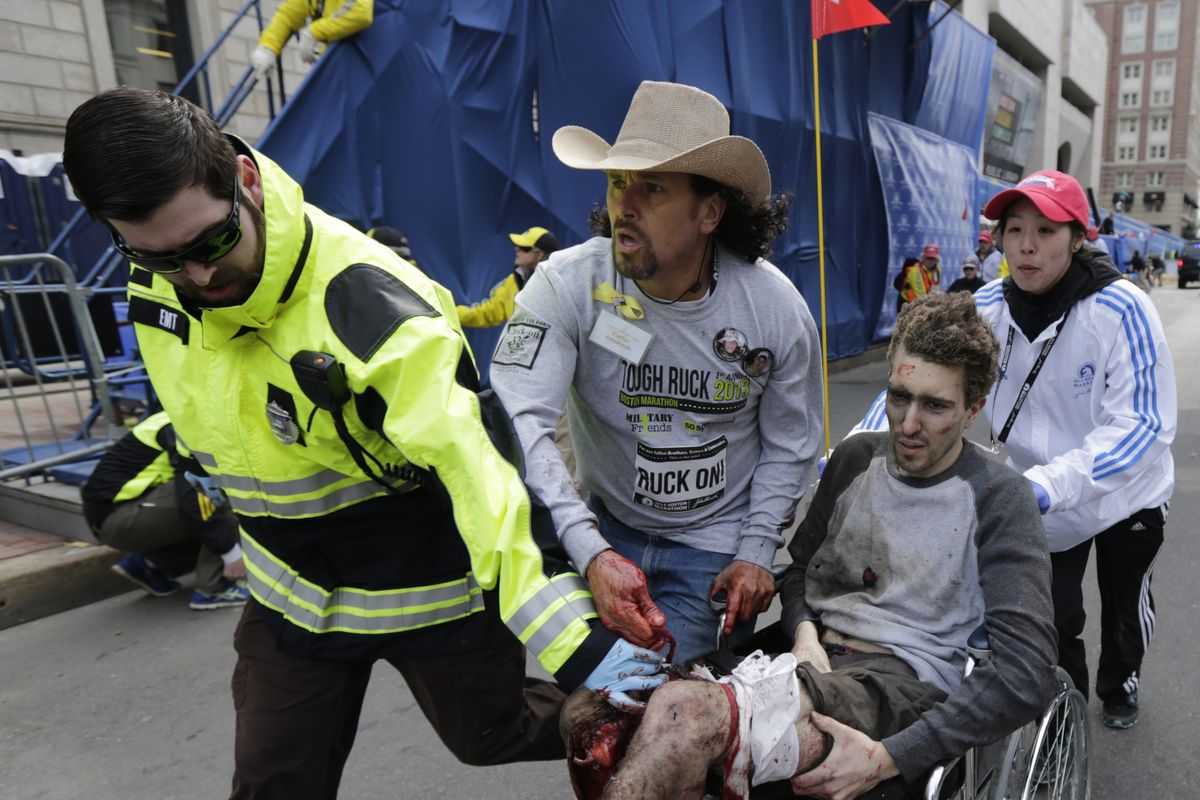Powerful blasts Rock marathon
Boston bombs leave three people dead, at least 140 injured

BOSTON – Two crude but deadly bombs ripped through crowds and turned the finish line of the Boston Marathon into a scene of chaos and carnage Monday, an attack that killed three, injured at least 140 and closed down parts of central Boston.
The back-to-back explosions near Boston’s Copley Square detonated near packed grandstands, severing limbs and causing serious shrapnel injuries to scores of spectators and others. Half a million people had gathered for the world-famous marathon that drew runners from 50 nations.
A large area near some of the city’s best-known landmarks was cordoned off, including the Boston Public Library and Prudential Tower. Police armed with assault rifles set up security posts outside hospitals where the wounded were streaming in with severed limbs and bloodied torsos.
“This was a very powerful blast. There were serious, serious injuries,” said Police Commissioner Edward Davis. “This cowardly act will not be taken in stride. We will turn every rock over to find the people who are responsible for this.”
A Saudi national was being questioned after being taken to a hospital for injuries, according to a federal law enforcement official, but there was no immediate indication whether investigators suspected a domestic or international terrorist plot. The official said authorities are also seeking a Penske rental truck seen leaving the race site.
“There was nothing, nothing on the radar screen” in terms of a terrorist threat, a U.S. Homeland Security official said.
Planes at Boston’s Logan International Airport were briefly held on the ground and a no-fly zone was established over the city as authorities attempted to clarify the extent of the attack.
President Barack Obama, who did not use the word “terror” in his address, pledged the full resources of the federal government to aid the victims and identify the perpetrators. He said security across the U.S. would also be stepped up as necessary.
“We still do not know who did this or why,” he said. “But make no mistake, we will get to the bottom of this. And we will find out who did this. We’ll find out why they did this. Any responsible individuals, any responsible groups will feel the full weight of justice.”
The incident occurred just before noon PDT, five hours into the race and about two hours after the first winners crossed the finishing line. The first explosion sent a burst of red flames into the air, followed by clouds of white smoke and shards of debris that rose up to three stories high near the photo bridge that marks the finish line on Boylston Street.
The second blast occurred about 13 seconds later, about 100 yards from the first.
Federal authorities said it was not known whether the devices were detonated remotely. Both bombs appeared to be unsophisticated and did not include plastic explosives, one federal official familiar with the investigation said.
An official from the federal Bureau of Alcohol, Tobacco, Firearms and Explosives said two additional devices were found and dismantled nearby. There was brief confusion when a fire was reported at the John F. Kennedy Library, but officials said later it was not related to the bombings.
At a news conference Monday night, officials would not comment on any additional devices.
At least one runner near the finish line fell to the ground while others began crying. Some spectators ran screaming from the scene while others rushed to aid victims.
“There was a lot of screaming, people running away. I mean, people were running like animals,” said Chuck Wagner, a 59-year-old retired SWAT officer from Oceanside, Calif., who was waiting for his son to cross the finish line when the first bomb went off about 60 feet away from him.
“You could smell explosives, so I knew right away it was not electrical,” he said. “I mean when that thing went off, I knew exactly what happened.”
“There was blood all over Boylston. And shattered glass everywhere,” said Maya Hauer, 23, who was two doors down from where the first bomb exploded.
Police spun their fingers in the air, directing runners and onlookers to flee. A race volunteer who declined to give his name said he rushed to help police rip apart metal barriers blocking access to the street as victims lay on the sidewalk on the other side.
“They were bleeding, injured, yelling,” he said. “Mayhem is a good word. Mayhem, chaos, all those words apply.”
Medical tents that had been set up to aid ailing runners became triage centers, with as many as 50 people seeking treatment in one of them.
“It was definitely chaos,” said Rick Bowles, a doctor in training for general surgery who grabbed his coat, medical shears and ID and rushed to the tent from his apartment when he heard the explosions.
Patients were transported to at least seven nearby hospitals where at least 140 were being treated for injuries, including eight children. At least 17 patients were in critical condition and 25 more suffered severe injuries. The hospitals remained on heightened security. An armored, green SWAT vehicle remained parked outside Brigham and Women’s Hospital.
Among the injured at Boston Children’s Hospital: a 2-year-old boy who was in intensive care with a head injury and several other children ranging in age from 7 to 14 with leg and head wounds.
Most patients had injuries to their lower extremities from what appeared to be a low-level blast, physicians said.
Dr. Peter Fagenholz, a trauma surgeon at Massachusetts General Hospital, said he operated on six patients, including several whose limbs were amputated. Others suffered bone, soft tissue and vascular injuries, he said.
Residents streamed out of their homes and offices and offered cellphones to dazed runners, but with service jammed in the hour or so after the attack, many resorted to texting. Spectators wandered around holding their former cheering signs aloft in a desperate attempt to find missing runners.